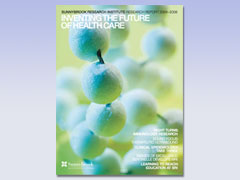A Rare Glimpse
The better the quality assurance in the operating room, the better a patient's chances for recovery and survival.
Or so the theory goes.
Historically, an absence of a particular kind of diagnostic imaging technology has meant coronary bypass surgery couldn't see the theory through. Surgeons' inability to look at the quality of a graft in the OR is a significant omission, considering the revelations of studies on postoperative patency and angiography: of grafts that fail, a number do so while the patient is on the table.
Enter the SPY system, a made-in-Canada angiography device that has revolutionized how—and, most significantly, when—grafts are assessed. The SPY system, which Sunnybrook cardiac doctors have been using since 2001, allows doctors to do an angiogram without using x-rays or a toxic-to-kidneys contrast dye. Instead, indocyanine green (a green pigment) injected into the vascular system is fluoresced with the near-infrared laser light of an imaging head that can penetrate up to two millimetres of soft tissue, and also houses a tiny video camera. The result is an image that surgeons can view on a computer screen at the end of a procedure, before the patient is sewn up, to gauge the graft's effectiveness. Graft problems it reveals—a stitch taken too deep, a vessel kinked off, a clot at the junction between two channels—can then be repaired in the OR. Its influence now extends to between 5% and 10% of the patients it monitors.
"It's real-time, real-life, clinically applicable research," enthuses Dr. Nimesh Desai, a research fellow and chief resident in cardiac surgery at Sunnybrook. "That's very gratifying, especially if you take a SPY angiogram of someone, find a problem and fix it right there. You've prevented a whole pile of grief in the long term."
Research on the SPY system was funded by the Canada Foundation for Innovation, Ontario Innovation Trust, and industry and private investment through the Imaging Research Centre for Cardiac Intervention. The Heart and Stroke Foundation of Ontario and Physicians' Services Incorporated Foundation provided operating grants.
PDF / View full media release »





